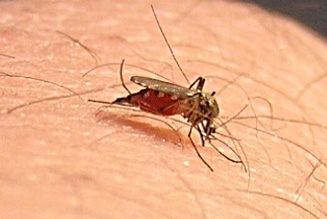

2015-07-01 Dott.sa Carla Petta posted:
Mosquitoes are small Diptera (3-7 mm. in length), with a marked sexual bimorphism: males have showy, feathery antennas (palps), while females have shorter antennas covered by only a few hairs. The reasons man considers the mosquito a pest is because its hygienic and sanitary effects are many: they puncture humans (because female mosquitoes need to drink blood before they can lay eggs), causing irritation which can develop into allergic reactions. They are vectors for pathogens, including arboviruses, plasmodium, filariasis, etc.
LIFECYCLE: Egg development is closely related to temperature: they need to hatch at a temperature in excess of 10-12° C, and ideally between 18 and 25° C. The time to hatching ranges between 1-2 days to 7-15 days if the temperatures are low. Only the eggs of the genus Aedes can hold out for months in dry environments. There are four development stages: egg, larva, pupa and adult. The first three stages are aquatic. Most species lay their eggs directly on the surface of the water. They hatch in a few days producing larvae that feed on organic particles and micro-organisms present in the water and breathe atmospheric air, so they can live on water with low oxygen content. The larvae will grow into pupae and adults; the latter shortly after emerging is already able to mate, starting a new cycle. The duration of the cycle is strongly influenced by water temperature and food availability. In particular, the summer months can see the biological cycle completed in under two weeks, giving rise to many generations.
The adult mosquito body is divided into three parts: head, thorax and abdomen. The head has the characteristic apparatus consisting of a needle-like central proboscis. This is grooved and forms the suction channel; next to the proboscis are two more dagger-like flaggelomere from the labrum and labium (upper jaw and mandible). The suction organs work in relation with the hypopharynx, where the salivary glands are located and operate on puncturing the skin to secrete a liquid irritant, with anticoagulant properties. The blood is sucked through the pumping action of the hypopharynx, which is a hollow structure. The buccal apparatus is completed by a pair of maxillary palps, which are particularly feathered in the male and aren't used for suction. In the thorax there is a protective shield which supports the only pair of wings on which there are large hair-covered veins. Culicinae have an abdomen covered in scales, while Anopheles has hairs instead. It is composed of 10 segments, the last 2 are stuck inside the eighth. The last segment carries two cerci in the female, and copulatory apparatus in the male. The abdomen has the halters, or completely transformed wings. Mosquitoes are holometabolous insects, which means they undergo complete metamorphosis of forms and habits along the various stages of the lifecycle. They feed on plant juices, sugars, decaying organic matter and flower nectar. The only females that bite animals, require a blood meal to complete ovulation, taking some essential amino acids from mammals, birds and amphibians. Mosquitoes fly in the twilight and at night, being characterised by a negative heliotaxis; they beat their wings in flight 2-300 times per second and can fly at a speed of 4-5 km per hour. They rarely stray far from where they emerged as adultsno more than 2-6 km. When possible, they avoid the wind, and swarm in rays after emerging as adults. During the day they shelter from light in dark places, in homes, or on plants foliage. The majority of mosquitoes have only one generation per year and males do not survive the winter.
Mosquitoes can be considered one of the most important examples of adaptation to the urban environment. Have colonized a whole range of reproductive sites made available by man with his activities, including tanks, septic tanks, cisterns, tanks for water softeners, open-air pipes, rainwater drains, clogged gutters, gully pots, plant saucers and watering cansall points where these bloodsucking Diptera can live undisturbed.
How much it cost?